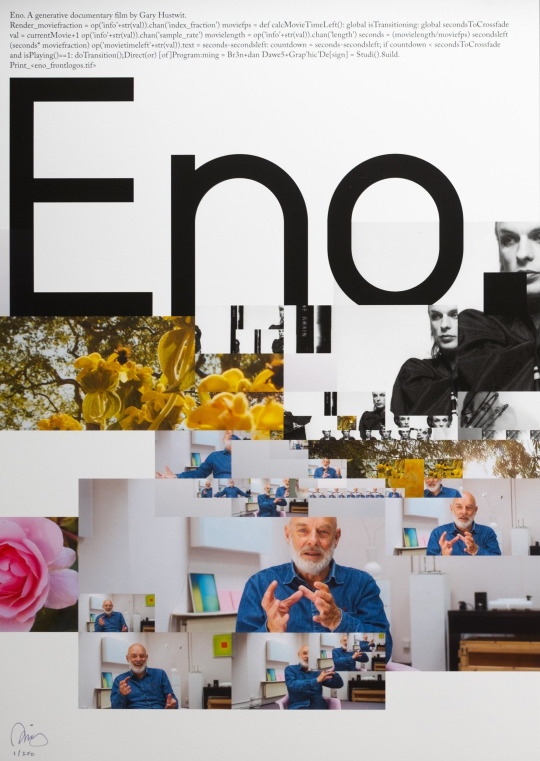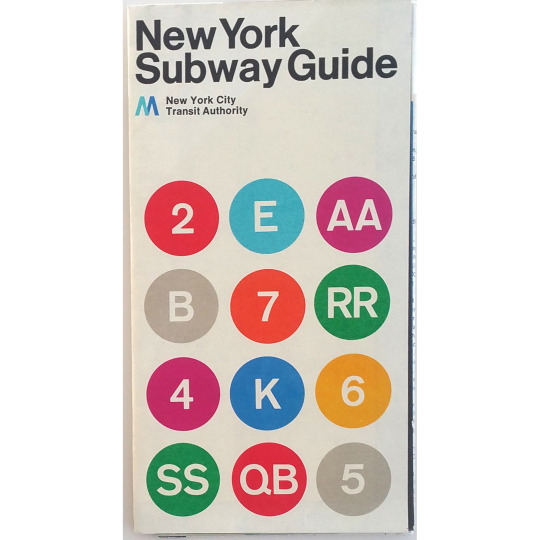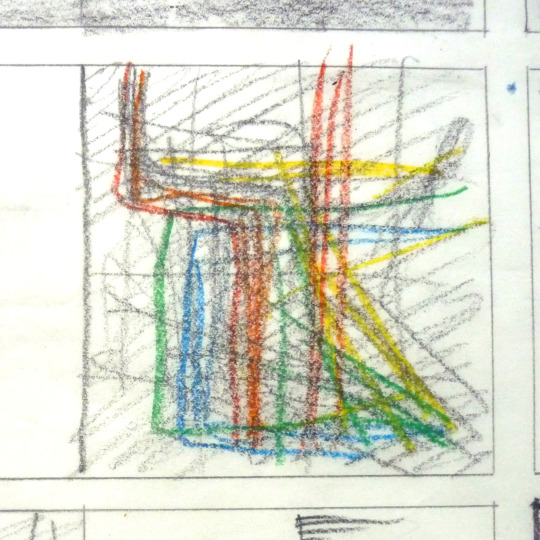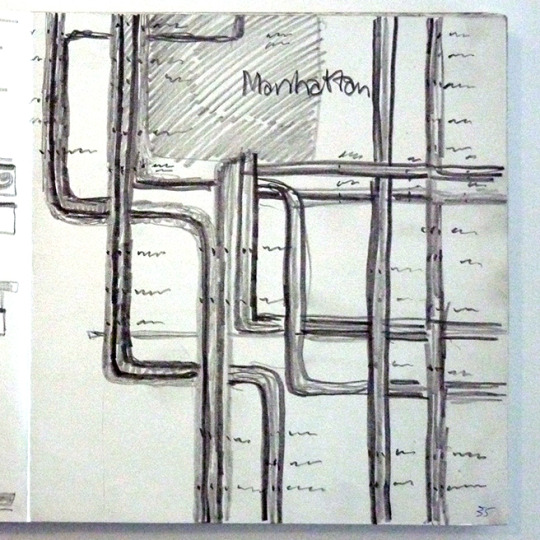#director Gary Hustwit
Explore tagged Tumblr posts
Text

Promo for Helvetica director Gary Hustwit's new Eno documentary.
31 notes
·
View notes
Text
Eno
A meditation on art, but really on humanity. An incredible film, viewed in a version (4.119) that has never been seen before and will never be seen henceforth. Introduced by director Gary Hustwit at the screening was the philosophical approach which won over Eno's participation in the first place. A film made to be altered and affect everyone differently. The software that randomly chooses segments to reorder the film is a testament to the cyclical nature of art and reinvention of form/ideas. This format is obviously also an homage to Eno's composing strategies (Music For Airports, etc...). As a gimmick it is fun to think about, and in execution was fairly brilliant. I was rapt from the first frame.
In his own words, Eno is able to articulate what exactly he does in imagining artistic space and playing with the ingredients until they feel just right. Scenes that were priceless included his appreciation of beetles discovered on a leaf, playing back his memo tapes (including an early U2 demo and a tape where a stoned-sounding Eno is repeating a cryptic mantra about self-hate and self-love), cursing at YouTube's barrage of ads, and using his homemade software. Talking to a dog about music as though it's something understood. Altering history in the studio by slowing down a U2 mix of "Pride..." on the console until it becomes something so compelling, sweeping and familiar. His remembrance of the music that made an impression on him in his youth was particularly captivating, as his passion for music and curiosity remains as potent now as it always has been.
Obviously the music (featuring various Eno projects including some I recognized) was stellar. The visualizations cycled between light/projection/fractured digital displays and a wonderful juxtaposition of nature and music scenes. Landscapes that evoke so much, paired with music that elevates every story, soundbite, and frame. The breadth of his work also impressed me, as I didn't know he did light installation work in addition to studio wizardry and his own sound manipulations. He dismissed criticism of pop music (via a discussion of a MOMA exhibition called "High Art, Low Art") and other forms of mainstream art and their perceived lack of creative value, instead theorizing that it is all part of a whole, the human experience that we all articulate in different ways. Each and every one of us makes gestures, sentences, decisions, sounds, pieces that are a pure and unique expression of ourselves. Creating art with an agenda of importance or societal value is obviously ambitious but, he argues, not necessarily the crux of the reason we all make art. It is about wanting to belong and translate our essence to others. Not only that, but the capacity of art to soothe, to heal, to change our perceptions about the world around us is so crucially important in the shadow of darkness that is our modern society.
The artists he worked with were definitely purely dedicated to their work in a way that is admirable - Bowie, Laraaji, Sinead O'Connor, David Byrne, Grace Jones, U2. His enhancements seem clear when listening back.
So many beautiful philosophical concepts kicking around in this film that landed with absolute sincerity for me, an antidote to my lurking cynicism. He sits on a bench in the park humming and talks about fiddling around for hours at a time with loops that never repeat the same way twice and it leaves me feeling alive, inspired, hopeful.
0 notes
Text
0 notes
Text
Week 11 - Summative assessment preparation session 1
For this first question, we were asked to create manifestos in a group. “An art/ design manifesto is a public declaration of the intentions, motives, or views of an artist/ designer or movement.”


We then looked at a written example of a manifesto about good design work, ”Dieter Rams: Ten principles for good design” . To me, that example explained what a designer would look for in his work or what he would want his audience to view when looking at his work. Another example we looked at was,” Stefan Sagmeister: Manifesto #9” which stated ways of how he lives his life and what he notices in people.



We looked at manifesto images like, “Red Alan's Manifesto, Grayson Perry (Royal Academician), 2014” as well, which mostly talks about how anything can be art. It also questions who decides whether art is good or bad. We looked at “John Maeda: The Laws of Simplicity” too which in definition states that simplicity even has its own complexities. I think when most people think of simplicity, people think of just a working project being easy to do and to understand. However, I believe that it is up to interpretation of how the audience views the work.


After looking at all the inspiration works, we understood that manifestos in terms of design is the concept of how we as designers make art. Each of us have different processes and different ways of thinking and I think that it really shows in our art styles and how we artistically perceive things around us as well. I think that creating a manifesto makes it clearer for an artist to be able to sense what concept they usually lean towards.

We then started on our manifesto and we decided to make it based on what we felt art was to each of us. I think that this in a sense broadened our perspectives to what art could be to each of us. My quote was chosen from the internet and it talks about the different factors of a good design. The picture can be seen below and to me, it creates a guide of how a designer should work towards their art projects. It gives them a checklist for them to know what to follow and it also influences generations of designers.
My takeaway from today’s topic is that everyone is going to have different perspectives on what art is and feels like to them. However, I think that that is what interests me about design and how it interacts with different audiences. Manifestos may be meant for designers to have a guide to follow but it also allows audiences that enjoy art to enter a different world where they get to explore different types of art.
Citations:
Accessed 22 October 2024.
0 notes
Text
The making of Eno, the first generative feature film
Director Gary Hustwit tells us about his living documentary and the technology that changes it for every screening. a:hover]:text-gray-63 [&>a:hover]:shadow-underline-black dark:[&>a:hover]:text-gray-bd dark:[&>a:hover]:shadow-underline-gray [&>a]:shadow-underline-gray-63 dark:[&>a]:text-gray-bd dark:[&>a]:shadow-underline-gray”>Image: First Film Corp.Brian Eno has taken many musical forms: producer, technologist, glam-rock star. Eno, the new documentary about the musician, also takes many forms, though more literally. Each showing of […] The post The making of Eno, the first generative feature film appeared first on TECH - WEB DEVELOPMENT NEWS. https://tech-webdevelopment.news-6.com/the-making-of-eno-the-first-generative-feature-film/
0 notes
Text
The making of Eno, the first generative feature film
Image: First Film Corp. Director Gary Hustwit tells us about his living documentary and the technology that changes it for every screening. Brian Eno has taken many musical forms: producer, technologist, glam-rock star. Eno, the new documentary about the musician, also takes many forms, though more literally. Each showing of the movie, which opens today in New York at Film Forum, will be a…
0 notes
Text
Helvetica Documentary Review
Director & Producer: Gary Hustwit, 12/09/2007
Would I use Helvetica in my designs? Yes, depending on the type of message and emotion that I want to convey. Would I use Helvetica for one context (type of work/audience) but not another? Yes, because I feel that type conveys emotion and Helvetica gives a clean, professional, possibly corporate and modern feel to it. Using that for a professional brochure for a corporate business or business card would be appropriate. However, if I were to create a piece of typographic work for an audience who prefers the grunge aesthetic or work that has emotion and colour to it, then using Helvetica would not be appealing to them. Erik Spiekerman in the documentary (00:39:17) states: "...typefaces are a brand. You're telling an audience 'this is for you' by using a certain typographic voice." And Paula Scher also supports this by saying (00:48:20): "I realised that type had spirit and could convey mood." In my opinion, Helvetica works in certain contexts but would not convey the same emotion or mood in another context. David Carson (graphic designer) said (00:58:36): "Don't confuse legibility for communication. Just because something's legible doesn't mean it communicates. And more importantly doesn't mean it's communicating the right thing." I completely agree, while other older designers in the documentary (Massimo Vignelli, Wim Crouwel) argue that Helvetica is good for everything due to it's neutrality, it doesn't necessarily convey the right moods for every single context. I think that designers are always influenced by the time they grew up in and live in, as time moves on, designers views on Helvetica have changed and evolved. Massimo Vignelli and Wim Crouwel lived in an age where Helvetica was revolutionary and the needed change from the chaos of the World Wars. Whereas more recent designers such as David Carson exist in a time where Helvetica felt overused and was trying to find new ways to design type, to create emotion rather than keep things clean and professional.
0 notes
Text
Helvetica Movie Review
Gary Hustwit, the director of the "Helvetica" film interviews a series of designers and artists on their experience with the font Helvetica. Hustwit even interviewed designers who were directly linked to the creation of the font! The film reflected on the font's creation, how society reacted to it when it was released and how artists felt towards helvetica or how they used helvetica in their designs. I found it interesting to see how revolutionary the font was for many businesses back then as Helvetica is a simple sans serif font with no outstanding characteristics, but that is what made the font special in its time — Being released in an era of script and fancy fonts. It was also surprising to see the amount of people in the film who had a very strong love for the font and grew endless inspiration from it.
0 notes
Photo










Happy 50th to the Vignelli NYC Subway map! The map was released 50 years and one day ago on August 4, 1972. Although it was only used by the NYCTA for a few years, it has become an iconic design. When it was replaced in 1978, the Cooper Union held a heated debate over the Vignelli map and its replacement. Sadly, the process work for designing this map is not in the archives, but we do have some rough sketches for layouts for the Design: Vignelli book by Vignelli and Michael Bierut. We also have Stan Ries’ photographs from the heated debate. Scroll through to see more artifacts from the archives to celebrate a half century since this map was released! Industrial Design Magazine [October 1972] published a glowing review of the then brand-new map titled “Straphanger’s guide: The New York City subway map is the light at the end of the tunnel” “Almost any revision of the New York City Transit Authority’s subway map would be clearly an improvement. However, the 1972 goes far beyond mere revision. The new map is not only well organized and color-coded, it has better typography–it is, in a word, readable.” “Designed by Unimark International¬–Massimo Vignelli was in charge of the project and worked with Joan Charysyn and Norbert Oehler–in cooperation and conjunction with Leonard Ingalls, Director of Public Information & Community Relations for the T.A. The map is offset printed n three sizes–for stations, trains, and pocket sized���by Diamond International Corporation.” –B.A.G.” Want more? Listen to Peter B. Lloyd tell the story of the subway map on our YouTube page: https://youtu.be/NAMq1MgA-i4 Listen to the Cooper Union recording of the debate which was recently digitized: https://greathallvoices.cooper.edu/Detail/programs/1086 Read “Vignelli Transit Maps” By Mark Overdon and Peter B. Lloyd https://www.rit.edu/press/vignelli-transit-maps Read “The New York Subway Map Debate” edited by Gary Hustwit, photos by Stan Ries, and forward by Paula Sher https://www.ohyouprettythings.com/new-products/subwaydebate
#vignelli#Unimark#design archives#design history#mta#nyc subway#half century#50th#1970s#subway debate#transit maps#design#graphic design#modernism
170 notes
·
View notes
Text
Leveling Up Fonts
Image 2: 1975 NASA Worm Logo In the movie Helvetica director Hustwit shows how societal preferences around fonts reflect the larger cultural movements of that time period (Helvetica). While Helvetica takes center stage throughout the movie, some of the more interesting parts are when designers revolted against Helvetica. One of the more amazing interviews was with a designer who discussed how the font Helvetica represented corporate America and corporate America supported the Vietnam War and that meant Helvetica, the font, embodied all the horrible values of the Vietnam War (Helvetica). While the readings from Benton and Gutjar & Benton primarily focused on how typeface can enhance, detract, or influence interpretation of written text (Gutjahr), Helvetica highlighted examples of corporate logos and how font impacted the corporate image (Helvetica). Since our design project this week is to produce a font to be used for advertising a spooky Polar Express escape themed room that evokes the 1910 – 1915 era, I decided to look at how fonts have changed over time for company logos.

Image 1: History of Sega Logo
The first company I explored was Sega. In looking at the font development, I learned quite a lot about Sega’s history. For example, I was surprised to learn that SEGA was founded by Americans who provided products such as slot machines to the US milatary bases (Sega Retro). It is this history that explains, why the first logo, for what was then called Service Games, appears to look like the American ads from the 1940s and 1950s that Hevetica showcased. The 1945 Service Games font (Image 1) shows the same sort of script font that Helvetica showed in a Coca Cola Ad. The next iteration of the SEGA font comes in 1956 when Service Games could no longer sell products within the United States and its territories due to a ban on gambling devices at which point the company pivoted to sell the devices to soldiers stationed in Asia (Sega Retro). The new logo reflected this change as the letters appear to be reminiscent of 3D origami (Image 1). The company was briefly a Japanese based company, but in 1974, SEGA once again became and American company and SEGA Japan was a subsidiary (Sega Retro). With this change, the logo once again changed and was more reflective of American tastes as seen in logos such as NASA (Image 1, 2).

Image 2: 1975 NASA Worm Logo
Works Cited
Gutjahr, Paul C., & Megan L. Benton. Illuminating Letter: Typography & literary Interpretation. Ed. Paul C. Gutjahr & Megan Banton. Amherst: U of Massachusetts P, 2001.
Helvetica. Dir. Gary Hustwit. 2007.
Prisco, Jacopo. “NASA's 'Worm' Logo Is Back. but Why Did It Disappear?” CNN, Cable News Network, 27 Apr. 2020, https://www.cnn.com/style/article/nasa-worm-logo-scn/index.html.
“Sega Logo.” 1000 Logos, DMCA Information, 10 May 2021, https://host.io/1000logos.net.
Sega Retro. “History of Sega.” Sega Retro, Sega Retro, 2021, https://segaretro.org/History_of_Sega.
3 notes
·
View notes
Photo


#153 Rams (2018)
Director: Gary Hustwit
United States /German
“The best design is no design”- Dieter Rams
The world is a messy place. Our contemporary culture is pieced together in a bewildering ad hoc manner, it’s a wonder it is functions to the level of sobriety that it seems to. To make my point, and offer up a contrast, watch a few episodes of Hoarders on Netflix. There you will witness just about every level of psychosis, filth and variety of trash that modern life has enabled. A condemned house filled with trash and tchotchkes, to the point of structural distress can be understood as the end point of the failure of design. Comedian George Carlin does a bit about us just building more spaces to put our useless stuff, and architect William Mc Donough talks about how any design, at the end of its functional lifespan, that winds up in the city dump, is a failure of design. It has become superfluous trash, a toxic layer of flotsam from modern culture’s ineptitude concerning waste within the specter of mass production.
Now watch the sparkling white Gary Huswit documentary of famous industrial designer Dieter Rams. Rams became best known for his painstakingly austere designs of modern products; record players, Braun shavers, furniture, etc. It’s a world view that despises clutter, unnecessary ornamentation, and shitty craftsmanship. Just for a moment, image a world like that.
People who are obsessively clean will love this documentary. It is a full expose on an uncluttered, well designed life. Everything is in its proper place and functionally considered. This point is driven home in the film by shots of Rams pruning his bonsai trees. Yes, it’s going to come down to those pesky details; the excessive packaging of products, the extra layers of paint to hide inferior construction, the mindless tchotchke on the shelf to help alleviate the expanse of ugly wall holding up the ugly shelves of our modern life. In the world of Dieter Rams, all this shit is pretty much gone, or addressed in such a way as to not continue to be shit. While Ram’s aesthetic –or anti aesthetic- might strike some as symptomatic of paranoia or fanatical control; I would welcome it as a fresh contrast to the quagmire the 21st century currently finds itself in. No point in clearing your mind in a yoga class only to trip over the clutter piled up in your living space when you get home. Ever been frustrated with a product so poorly designed the better option is to just discard it? Ever confronted the bewildering array of components required to plug in or charge electronics. There’s miles of this stuff… years of it. Can’t we just step back from the acceleration and think it through a little better before we commit to a million of something. I think it’s dawning on us that we have the dangerous capability of taking bad ideas extremely far.
I get the sense mankind is trying to sort some of this stuff out. Larger mechanisms and institutions in our global life, held over from the last half of the twentieth century, don’t seem to be aging very well. There is a lot that needs to be reconsidered, simplified, and implemented with more care. Dieter Rams stands as the epitome of high modernism in the world of design. The twentieth century was supposed to have cleared up a lot of unnecessary stuff, that was the main thrust anyway. Condescendingly, we can see modernism’s quest as somewhat quaint now – that noble but naïve world held up by gasoline, steel girders, and Helvetica, seems to have spun out of control. But here is where Dieter Rams and his monk like austery seems like a radical idea again. I long for simplified design. I think the world is getting over designed, and overly complicated, and this takes its toll on every level of our existence. I’m not a luddite. I enjoy and prosper from the technological breakthroughs, but too much is too much. Not everyone needs a cooking show, not everyone should be famous or noticed. At some point it might serve to nurture the essential. Someone can design a good product that works and doesn’t break the bank. We can question planned obsolescence in pursuit of making something worth a damn, that’s not too much to ask.
Dieter Rams saw this coming. He saw it in the world around him and he did something about it. You may not like him, his vision or his products. Perhaps your world is world a little fuzzier around the edges; a world that prefers the musty dirty patina of time, the stained pages of history with its grimy fingers, and abhors the antiseptic whiteness of modernism. If so, Dieter Rams is not your hero. But the film is worth the watch to anyone. If anything it shows what modernism might have been, what kind of clean utopian organization it offered, a clean quiet respite in a world that was quickly succumbing to the effects of rapidly multiplying shittyness.
Worth the watch, worth the consideration.
https://filmjrnl365.tumblr.com
11 notes
·
View notes
Note
For the movie asks: 47 and 50 please!
47 - Movies that you think everyone should watch (not necessarily your favorites).
Okay im gonna put my favorite movie anyway bc it really deserves all the love
Scott Pilgrim vs. The World is a literal masterpiece. Edgar Wright’s direction SHINES in this film and there are so many things that are just GENIUS. The soundtrack is incredible, the transitions and timing and sound design are fantastic. the CAST is incredible too. i love everything about this movie. ive watched it like 30+ times lol
Zodiac dir. by David Fincher is rly interesting to me because he took so much time into really recreating the time period when they were trying to find the zodiac killer
The Witch dir. by Robert Eggers is SO good too. i think it was incredible how committed he was to having the film be accurate to the time period (can u tell i like historical dramas lol)
this one is a lil personal to me as a designer but Urbanized dir. Gary Hustwit was a super cool documentary on urban design. it rly changed the way i approach the human aspect design and it was really inspiring! i think when people watch it, you tend to look at the way urban environments are built and curated.
50 - A book you really, really, really don’t want to see made into a film.
uh. i dont read a lot and most of the books ive read are already movies.
but i will mention theres something to be said about western directors adapting asian movies and animation to fit a western audience and it REALLY grinds my gears.
i heard somewhere that parasite was going to be adapted into a show for HBO and im like :/
i hate the mentality that asian made art needs to be changed and altered, because by doing so you remove the cultural significance of that work. parasite is a KOREAN film critiquing KOREAN class structures; the dumb assholes who said that it needed to be dubbed in order for western audiences dont realize that dubbing it would take away many of the significant messages and themes of the movie (EX. intermittent english is a symbol of WEALTH. thats why the rich family uses konglish in times of the movie)
the same thing goes for anime/ anime movies. there was a rumor that Your Name dir. by Makoto Shinkai (highly recommend) was going to be adapted for an American audience and the story is set in America and I’M LIKE ://////
Your Name has a lot of references to japanese shintoism and not only do you lose that cultural significance, but you also lose the impact of the animation. there are just some things you cant capture on camera like you can in animation. im tired of anime/animation being snubbed as a lesser medium
LET ASIAN STORIES EXIST, LET PEOPLE TELL ASIAN STORIES. NOT EVERYTHING NEEDS TO BE MADE FOR A WESTERN AUDIENCE.
THANK U FOR COMING TO MY TED TALK
2 notes
·
View notes
Text
Summary #3
Erik Spiekermann has written a Foreword for David B. Berman’s book do good design. In his concise, down to earth manner, Spiekermann sheds light on some of the choices we do and don’t have control over as designers. One thing that he defines as being completely in our control is how we work. How we go about our process, and all the interactions that entails, is our most sure tool in making the difference we want to see not only in our industry but in the world around us.
To wrap up his book do good design, David B. Berman lays out a three step pledge for designers to take:
I will be true to my profession.
I will be true to myself.
I will spend at lease 10 percent of my professional time helping repair the world.
Berman goes into each step of the pledge to break down the process. The first step can be as simple as joining and adhering to a professionally determined set of ethics through an organization, such as RGD. In his second step Berman asks us to be good people. Do what we know to be right, offset negative impacts. The third and final step asks us to help others who are carrying out step two; help others be good people.
In chapter two of Design to Renourish, Eric Benson and Yvette Perullo discuss systems thinking as it pertains to graphic design. Everything in the natural world which sustains us is interconnected, and graphic design is no exception. As designers, we must ask ourselves how our approach to designing can improve everything for everyone, not just satisfy the client budget. We must seek to improve the triple bottom line in everything we do. This includes understanding all the biological systems we will effect (biomimicry). To grasp the full scope of our design impact, and incorporate that understanding, Benson and Perullo suggest this systems design process:
Determine project goals (understand your audience, form creative brief).
Map out design problems (problem/audience mapping, personas).
Brainstorm design outcomes (define all possibilities).
Evaluate each possible project outcome (in depth).
This holistic evaluation will help us interconnect our design phases and zoom in and out on each element to understand the whole.
10 Principles for Good Design is Dieter Rams’ guide to designing sustainably. The selection of principles encourages the creativity and functionality of design while including sustainability as their equal. Overall the list speaks to designing mindfully and with a bigger-picture awareness of one’s work.
In his 2009 documentary Objectified, producer and director Gary Hustwit guides viewers through interviews with multiple designers as they speak about their relationship to products of design. Henry Ford is quoted having said “Every object tells a story if you know how to read it.” For some, the story is in the object’s conceptualization, for others the story is in the memories layered onto the object over time. If the true value of an object or product comes from our personal relationship with it, then certainly as Bill Moggridge says, we should be designing products to withstand “wearing-in rather than wearing-out.” In this way, consumer needs can be met in a more sustainable manner, with products that represent more than just a dollar value to those purchasing them; mindfulness in every stage of product life.
t-t-t-take-aways:
Practice mindfulness
The ‘how’ is in our hands
Get smart/expand your horizons
Help others help others
Design for longevity
1 note
·
View note
Text
A new Brian Eno documentary is in the works
A new Brian Eno documentary is in the works
A new documentary about Brian Eno is in preparation by the director Gary Hustwittit is announced. Hustwit has already worked on films on Mavis Staples (Mavis!) and Wilco (I’m Trying to Break Your Heart: A Wilco Film). The filmmaker’s official website now offers a page for a documentary titled Enowhich is described as “the definitive cross-platform documentary on the entire career of a visionary…
View On WordPress
0 notes
Text
A new Brian Eno documentary is in the works
A new Brian Eno documentary is in the works
A new documentary about Brian Eno is in the works by director Gary Hustwit, it has been announced. Hustwit has previously worked on films about Mavis Staples (Mavis!) and Wilco (I Am Trying to Break Your Heart: A Film About Wilco). The filmmaker’s official website now features a page for a documentary called Eno, which is described as “the definitive career-spanning, multi-platform documentary…

View On WordPress
0 notes
Text
New Brian Eno Documentary in the Works
New Brian Eno Documentary in the Works
A new documentary about Brian Eno is in the works. The career-spanning Eno is helmed by Helvetica director Gary Hustwit, who was granted access to hundreds of hours of never-before-seen footage, unreleased music from Eno’s archive, and visual art. The film will be released in multiple versions. According to a press release, Eno will employ “groundbreaking generative technology in its creation and…
View On WordPress
0 notes